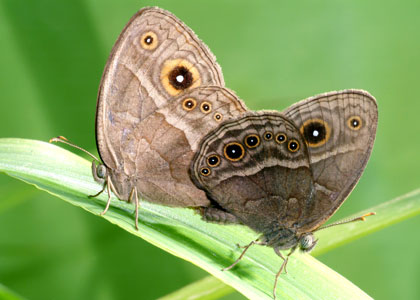Some
male animals resort to bright colors or impressive physical displays to
win over the ladies, but a new study shows that a simple sparkle can do
the trick. Male Bicyclus anynana butterflies exhibit small reflective patches on their wings that females find irresistible.
 |
Sitting pretty. The white pupils in the eye patterns of male butterfly wings reflect UV light that attracts females.
CREDIT: W.H. Piel, © 2005 |
The wings of Bicyclus anynana
butterflies contain spots that resemble eyes, each with a central white
"pupil." Previous studies have suggested that the eyespots confuse
predators, diverting attention away from the butterfly's vital organs.
However, the insects also display the eyes on their inner dorsal wings,
which are less visible to predators. "We were always puzzled, wondering
what ... are they there for?" says Antónia Monteiro, a biologist at the
University of New York at Buffalo.
To investigate the function of the spots, Monteiro's team, led by
graduate student Kendra Robertson, collected more than 1700 butterflies
from the lab's colony. The researchers found that females tended to
flock to males who had white pupils within their dorsal eyespots, which
are exposed by wing flickering during courtship. "I was so shocked that
they were selectively interested in this one tiny pupil when there are
so many other intricate designs," says Robertson.
Because the pupils are composed of a thin scaly layer of cells that
reflect ultraviolet (UV) light, the team wondered if the UV sparkle
lured the females. To test this, the researchers dabbed the pupils of
over 50 males with a UV-absorbing pigment that did not change their
wing coloration. When introduced to treated and untreated males, female
butterflies were twice as likely to mate with males that reflected
regular levels of UV.
Males with more UV reflectivity probably look younger and healthier and
are thus a bigger draw for females, says Robertson. This may be because
butterflies lose their reflectivity over time as the scales on the
wings get chipped away. The team will report its findings online 6 July
in Proceedings of the Royal Society B: Biological Sciences.
"The results are convincing, and the outcome is amazing," says Ronald
Rutowski, a biologist at Arizona State University in Tempe. But one
wrinkle, he points out, is that the amount of UV light available in the
environment can change from one habitat to the next. "It would be
interesting to see how quality of light affects these experiments," he
says.
--CATHY TRAN
Related sites
Monteiro Lab site, including more pictures of Bicyclus
More about Butterfly Wing Patterns
| 
![]() Copyright © 2005 by the American Association for the Advancement of Science.
Copyright © 2005 by the American Association for the Advancement of Science.